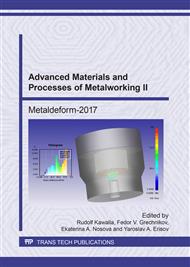[1]
Zittel, G. A historical review of high speed metal forming. Met. Form., 2010: p.2–15.
Google Scholar
[2]
James, W.B., Dermott, M.J., Powell, R.A. Forming and Forging, Volume 14, 9 Edition of Metals Handbook, ASM International, (1988).
Google Scholar
[3]
H. Wolf: Application of Electromagnetic Forces for Powder Compaction and Joints, Proc. of the 7-th International Conference of High Energy Rate Fabrication, Leeds, UK: (1981).
Google Scholar
[4]
V. Mironov: Pulververdichten mit Magnetimpulsen, Plansee-Bericht fuer Pulvermet., Vol. 24, 1976, pp.175-190.
Google Scholar
[5]
I. Molochkov, M. R. Leruma, V. A. Mironov, U. Ya. Sedmalis. Combined impulse-static method of pressing technical ceramics. Glass and Ceramics (1989). Translated from Steklo i Keramika, No. 10, p.15–17, October, (1989).
DOI: 10.1007/bf00678947
Google Scholar
[6]
Zemchenkov V., Mironov V., Viba I. Investigation of technological processes with electromagnetic impulses. In Proc. of 3rd Int. Conf. of DAAAM, 2002, Tallinn, pp.307-310.
Google Scholar
[7]
S. Paranin, V. Ivanov, A. Nikonov, A. Spirin, V. Khrustov, S. Ivin, A. Kaygorodov, and P. Korolev. Advances in Science and Technology 45, 899 (2006).
Google Scholar
[8]
Kim J.H., Rumman M.R., Rhee C.K., Lee J.G., Lee M.K. & Hong S.J. (2011).
Google Scholar
[9]
Boltachev G. Sh., Nagayev K.A., Paranin S.N., Spirin A.V., Volkov N.B. Magnetic Pulsed Compaction of Nanosized Powders. NY: Nova Science Publishers, Inc., (2010).
Google Scholar
[10]
Soon - Jik Hong, Md. Raihanuzzaman Rumman and Chang Kyu Rhee. Effect of Magnetic Pulsed Compaction (MPC) on Sintering Behavior of Materials. Sintering of Ceramics - New Emerging Techniques, Edited by Dr. Arunachalam Lakshmanan. 2012. pp.159-176.
DOI: 10.5772/35372
Google Scholar
[11]
V. Mironov, V. Zemchenkov, and V. Lapkovsky: Model of the Magnetic packing's of dispersed materials, " Transactions of the VŠB-Technical University of Ostrava, 2009, pp.249-253.
Google Scholar
[12]
B. Chelluri and E. Knoth: Powder Forming Using Dynamic Magnetic Compaction, 4th International Conference on High Speed Forming, 2010, pp.26-34.
Google Scholar


